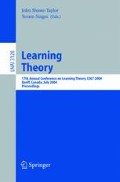Abstract
The Bayes classifier achieves the minimal error rate by constructing a weighted majority over all concepts in the concept class. The Bayes Point [1] uses the single concept in the class which has the minimal error. This way, the Bayes Point avoids some of the deficiencies of the Bayes classifier. We prove a bound on the generalization error for Bayes Point Machines when learning linear classifiers, and show that it is at most ~1.71 times the generalization error of the Bayes classifier, independent of the input dimension and length of training. We show that when learning linear classifiers, the Bayes Point is almost identical to the Tukey Median [2] and Center Point [3]. We extend these definitions beyond linear classifiers and define the Bayes Depth of a classifier. We prove generalization bound in terms of this new definition. Finally we provide a new concentration of measure inequality for multivariate random variables to the Tukey Median.
Access this chapter
Tax calculation will be finalised at checkout
Purchases are for personal use only
Preview
Unable to display preview. Download preview PDF.
References
Herbrich, R., Graepel, T., Campbell, C.: Bayes point machines. Journal of Machine Learning Research (2001)
Tukey, J.: Mathematics and picturing data. In: proceeding international congress of mathematics, vol. 2, pp. 523–531 (1975)
Matousěk, J.: Lectures on discrete geometry. Springer, Heidelberg (2002)
Caplin, A., Nalebuff, B.: Aggregation and social choice: A mean voter theorem. Exonometrica 59, 1–23 (1991)
Vapnik, V.: Statistical Learning Theory. Wiley, Chichester (1998)
Novikoff, A.B.J.: On convergence proofs on perceptrons. In: Proceedings of the Symposium on the Mathematical Theory of Automata, vol. 12, pp. 615–622 (1962)
Donoho, D., Gasko, M.: Breakdown properties of location estimates based on halfspace depth and projected outlyingness. Annals of Statistics 20, 1803–1827 (1992)
Bagnoli, M., Bergstrom, T.: Log-concave probability and its applications (1989), http://www.econ.ucsb.edu/~tedb/Theory/logconc.ps
Ledoux, M.: The Concentration of Measure Phenomenon. American Mathematical Society, Providence (2001)
Bertsimas, D., Vempala, S.: Solving convex programs by random walks. In: STOC, pp. 109–115 (2002)
Freund, Y., Seung, H., Shamir, E., Tishby, N.: Selective sampling using the query by committee algorithm. Macine Learning 28, 133–168 (1997)
Haussler, D., Kearns, M., Schapie, R.E.: Bounds on the sample complexity of bayesian learning using information theory and the vc dimension. Machine Learning 14, 83–113 (1994)
Vapnik, V., Chervonenkis, A.Y.: On the uniform covergence of relative frequencies of events to their probabilities. Theory of Probability and its Applications 16, 264–280 (1971)
Bartlett, P., Mendelson, S.: Rademacher and gaussian complexities: risk bounds and structural results. Journal of Machine Learning Research 3, 463–482 (2002)
Littlestone, N.: Learning quickly when irrelevant attributes abound: A new linearthreshold algorithm. In: 28th Annual Symposium on Foundations of Computer Science, pp. 68–77 (1987)
Talagrand, M.: Concentration of measure and isoperimetric inequalities in product space. Publ. Math. I.H.E.S. 81, 73–205 (1995)
Zuo, Y., Serfling, R.: General notions of statistical depth function. The Annals of Statistics 28, 461–482 (2000)
Prekopa, A.: Logarithmic concave measures with applications to stochastic programming. Acta Sci. Math. (Szeged) 32, 301–315 (1971)
Borell, C.: Convex set functions in d-space. Periodica Mathematica Hungarica 6, 111–136 (1975)
Author information
Authors and Affiliations
Editor information
Editors and Affiliations
Rights and permissions
Copyright information
© 2004 Springer-Verlag Berlin Heidelberg
About this paper
Cite this paper
Gilad-Bachrach, R., Navot, A., Tishby, N. (2004). Bayes and Tukey Meet at the Center Point. In: Shawe-Taylor, J., Singer, Y. (eds) Learning Theory. COLT 2004. Lecture Notes in Computer Science(), vol 3120. Springer, Berlin, Heidelberg. https://doi.org/10.1007/978-3-540-27819-1_38
Download citation
DOI: https://doi.org/10.1007/978-3-540-27819-1_38
Publisher Name: Springer, Berlin, Heidelberg
Print ISBN: 978-3-540-22282-8
Online ISBN: 978-3-540-27819-1
eBook Packages: Springer Book Archive

